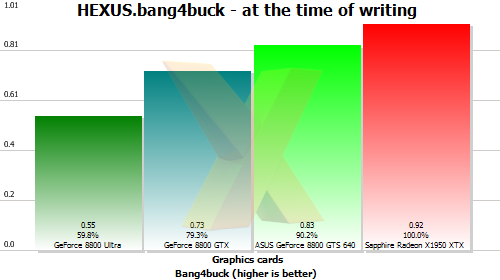HEXUS.bang4buck
HEXUS.bang4buck
In a rough-and-ready assessment of the card's bang per buck, we've aggregated the average 1920x1200 4xAA 8xAF framerates for the three games, normalised them*, and listed the cards' price. There are more provisos than I care to shake a stick at. We could have chosen three different games, the cards' prices could have been derived from other sources and pricing is such that it can fluctuate daily. However, to reiterate, the graph below highlights a metric that should only be used as a yardstick for evaluating comparative performance with price factored in. Other architectural benefits are not covered, obviously.| Graphics Cards | NVIDIA GeForce 8800 Ultra 768MiB | NVIDIA GeForce 8800 GTX 768MiB | ASUS EN8800GTS/HTDP/640M 640MiB | Sapphire Radeon X1950 XTX 512MiB |
|---|---|---|---|---|
| Actual aggregate marks at 1920x1200 4xAA 8x(16x)AF | 366.81 | 329.85 | 238.64 | 232.12 |
| Aggregate marks, normalised**, at 1920x1200 | 273.4 | 254.92 | 209.31 | 206.06 |
| Price - at time of writing | £499* | £350 | £252 | £225 |
| HEXUS.bang4buck score | 0.548 | 0.728 | 0.831 | 0.916 |
| Acceptable framerate (60FPS av.) at 1920x1200 4xAA 8/16xAF | Yes | Yes | Yes | Yes |
* - best-guess price, as per RRP.
** - The normalisation refers to taking playable framerate into account. Should a card benchmark at over 60FPS in any one game, the extra FPS counts as half. Similarly, should a card benchmark lower, say at 40FPS, we deduct half the difference from its average framerate and the desired 60FPS, giving it a bang4buck score of 30 marks. The minimum framerate, then, can be 20FPS, as that will score 0.
As an example, should a card score 120FPS we count it as 90FPS (120 - (120-60)/2) as only half the framerate above 60FPS is counted for the bang4buck. Similarly, should it score 30FPS we count it as only 15FPS (30 + (30-60)/2).
The reasoning behind such calculation lies with playable framerates. Should card A score 110FPS in a benchmark and card B 160, then card B would normally receive an extra 50 marks in our bang4buck assessment, even though both cards produce perfectly playable framerates and anything above 60FPS is a bonus and not a necessity for most. However, the bang4buck total would be identical if in another benchmark card A scored a smooth 70FPS and card B an unplayable 20FPS, as both aggregate to 180 marks, yet the games-playing experience would be vastly different. You would, on balance, say that card A was better because it ran smoothly in both games. In our revised aggregation, card A would receive 150 marks (85 + 65) and card B 100 (100 + 0).
In effect, we're including a desired average framerate, in this case 60, and penalising lower performance whilst giving higher-than 60FPS framerates half as much credit as the framerate up to 60FPS. If that doesn't make sense or you have issue with it, please hit the HEXUS community.
And here is the HEXUS.bang4buck in pictorial form, highlighting normalised performance divided by street price.

Undeniable single-card performance leadership is hampered by a high, high RRP, as evinced on our HEXUS.bang4buck graph. You'll pay through the nose for the fastest graphics card in town, and the GeForce 8800 GTX, available for a while now, would be the better value bet if speedy DX10 gaming is what you need right now.









